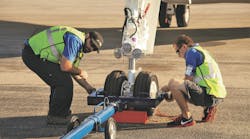Nov. 30--American Airlines and its parent company filed for bankruptcy protection Tuesday to cut costs and restructure in a time of economic uncertainty and volatile fuel prices.
The move prompted speculation that American might tie the knot with another big airline. The most likely suitor: US Airways Group Inc., Philadelphia's dominant airline.
"We believe today's filing by American potentially works to the advantage of US Airways," analyst Kevin Crissey, of UBS Securities L.L.C., wrote in a client note. "American potentially needs a partner to achieve more scale, and US Airways may provide that avenue."
But a merger will happen only if new American CEO Thomas Horton, named Tuesday to replace retiring chief executive Gerard Arpey, is interested. His predecessor was not, said veteran airline analyst Bob McAdoo, of Avondale Partners L.L.C.
"There are substantial business reasons why a merger with US Airways would give American Airlines a far more widespread presence in the eastern one-third of the country," McAdoo said.
A US Airways-American combination would help American compete better across the Atlantic in Europe.
By the numbers, US Airways' Philadelphia hub effectively collects passenger traffic out of the Northern and Eastern United States to Europe, and generates more revenue to and from Europe each day than American does at either New York's JFK or Chicago's O'Hare airport, McAdoo said.
A merger with US Airways also would give American, which is strong in the Midwest and West, as many as 60 new cities to serve.
As the only major U.S. airline that did not seek bankruptcy protection after the Sept. 11 attacks, American has continued to lose money as other U.S. carriers have returned to profitability in recent years.
Two weeks ago, Standard & Poor's lowered its ratings on American, citing the company's failure to get a new contract with its pilots' union before reporting a $162 million third-quarter loss.
American said Tuesday that it would operate flights, honor tickets, and take reservations while it reorganizes.
The Fort Worth, Texas-based company has three gates at Philadelphia International Airport and 16 daily departures -- 11 on American and five on American Eagle. American flies to Dallas, Chicago, and Miami and has 3.5 percent of the market here.
The bankruptcy filing was not a surprise, but the timing was, said Seth Kaplan, managing partner of Airline Weekly, an industry publication.
American said everything would be normal for now, but the airline will shrink -- in aircraft, employees, and routes. American hubs like Dallas and Miami may escape relatively unscathed, while Los Angeles and Chicago could be more vulnerable, Kaplan said.
The bankruptcy will not necessarily lead to a merger.
"They should be able to stand alone," he said, "but certainly a merger is now more likely."
American's cost structure had been the biggest roadblock to merger. Bankruptcy provides flexibility and has led to other recent matches, such as Delta-Northwest and United-Continental.
US Airways, the fifth-largest U.S. airline, favors industry consolidation. It made a hostile takeover bid for bankrupt Delta Air Lines in 2007 and twice was in merger talks with United Airlines.
With the bankruptcy, American will be able to renegotiate aircraft leases, return inefficient planes, and renegotiate contracts with its pilots, who will likely see their pension plan restructured, analyst Helane Becker, of Dahlman Rose & Co., wrote.
The Chapter 11 filing is "good for the entire industry," said analyst James Higgins, of Ticonderoga Securities L.L.C. "By filing now, with ample unrestricted cash, American can avoid the customary need for debtor-in-possession financing, and is likely to retain more control over its reorganization."
Higgins predicted that American would emerge as a stand-alone airline, and that even if American and US Airways someday tied the knot, "I would be surprised if it happened as part of this bankruptcy process."
Since American has $4.1 billion in cash, chances are less that US Airways could persuade creditors that a merger "is better for them," he said.
A US Airways-American combination would be "a good fit" from an industry standpoint, Higgins said, and Philadelphia would likely remain a hub.
"I don't think American is strong enough in New York to give up Philadelphia as a hub," he said.
American History
1930: American Airways is incorporated. The company includes several small airmail contractors. It becomes American Airlines Inc. in 1934.
1979: American undertakes a major route expansion after deregulation of the industry. The headquarters moves from New York to Fort Worth, Texas.
1982: The current AMR Corp. is formed.
January 2001: American says it will buy the assets of Trans World Airlines.
Sept. 11, 2001: Terrorist attacks include the crashes of two American Airlines jets.
2003: American narrowly avoids bankruptcy after workers agree to sharp pay cuts.
Nov. 29, 2011: American Airlines and parent AMR file for bankruptcy protection.
SOURCE: American Airlines, Associated Press archives.
Copyright 2011 - The Philadelphia Inquirer




